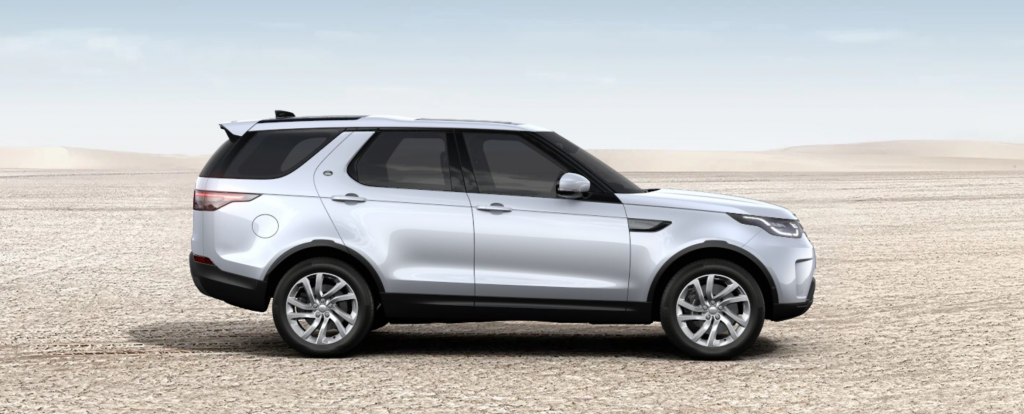Chris Riley tests the 2023 Jeep Grand Cherokee L Summit Reserve with pricing, specs, ride and handling, safety, verdict and everything the over-50 driver needs to know.
Summary: The Jeep Grand Cherokee is now available with three rows of seats, but it’s big, thirsty and expensive, especially in top spec trim.
2023 Jeep Grand Cherokee L Summit Reserve large SUV
Pricing: $119,450 (plus on road costs)
Options: premium paint $1750, sunroof $2450 (Night Eagle), dual pane sunroof and head-up display $4250 (Limited), wireless phone charging, night vision, front passenger interactive display (package) $5500 (Summit Reserve)
Warranty: Five-years/100,000 km, five-year/100,000km roadside assist
Safety: not tested
Build location: United States
Engine: 3.6-litre naturally aspirated 6-cylinder DOHC petrol
Power: 210kW at 6400rpm
Torque: 344Nm at 4000rpm
Transmission: 8-speed sports automatic, four-wheel drive
Body: 5202mm (long); 1979mm (wide); 1817mm (high)
Weight: 2307kg
Towing capacity: 2268kg
Wheels: 21-inch alloy
Tyres: 275/45 R19
Ground clearance: up to 276mm
Approach angle: 30.1 degrees
Departure angle: 23.6 degrees
Breakover angle: 22.6 degrees
Wading depth: 610mm
Fuel tank capacity: 87 litres
Official consumption: 10.6L/100km (91 RON petrol)
Consumption on test: 10.9L/100 (800+km)
seniordriver consumption on test: not tested
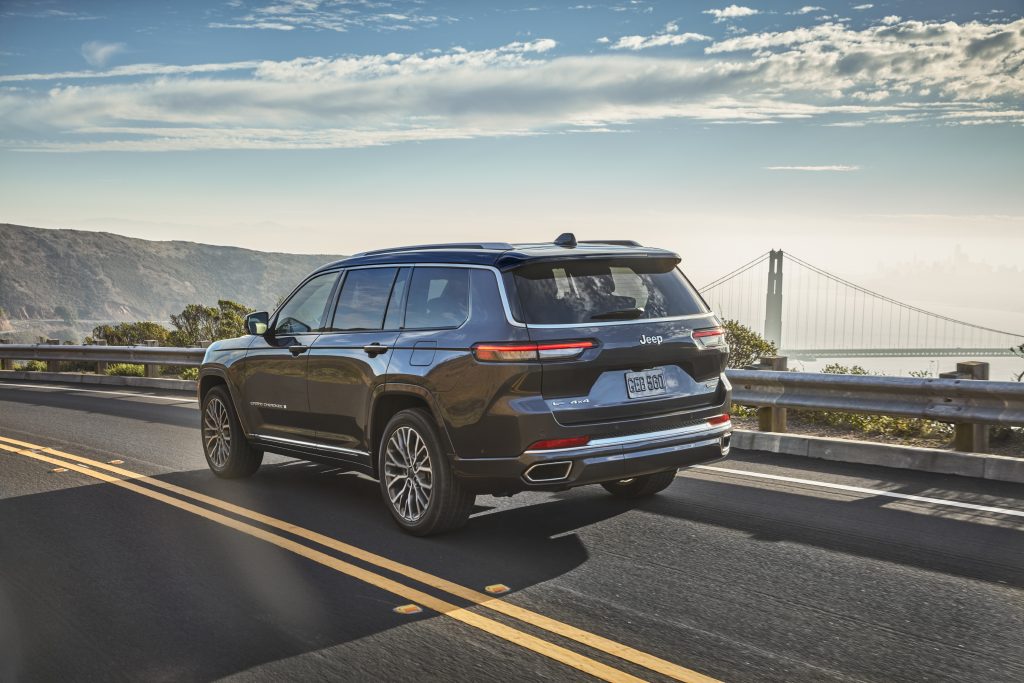
[review]
Launched last year Jeep’s Grand Cherokee L (for long wheelbase) offers three rows of seats for the first time.
It has been a long time coming for a car that has struck an emotional chord with Aussies, but until now has been off limits to those with larger families.
There’s just one hitch and that is apart from one diesel Compass, all Jeeps now come with a petrol engine in what has long been a diesel-dominated section of the market.
Jeep has hybrid and electric powertrains on the way, but the first of them won’t get here until probably the end of the year which could be problematic for the iconic American car maker.
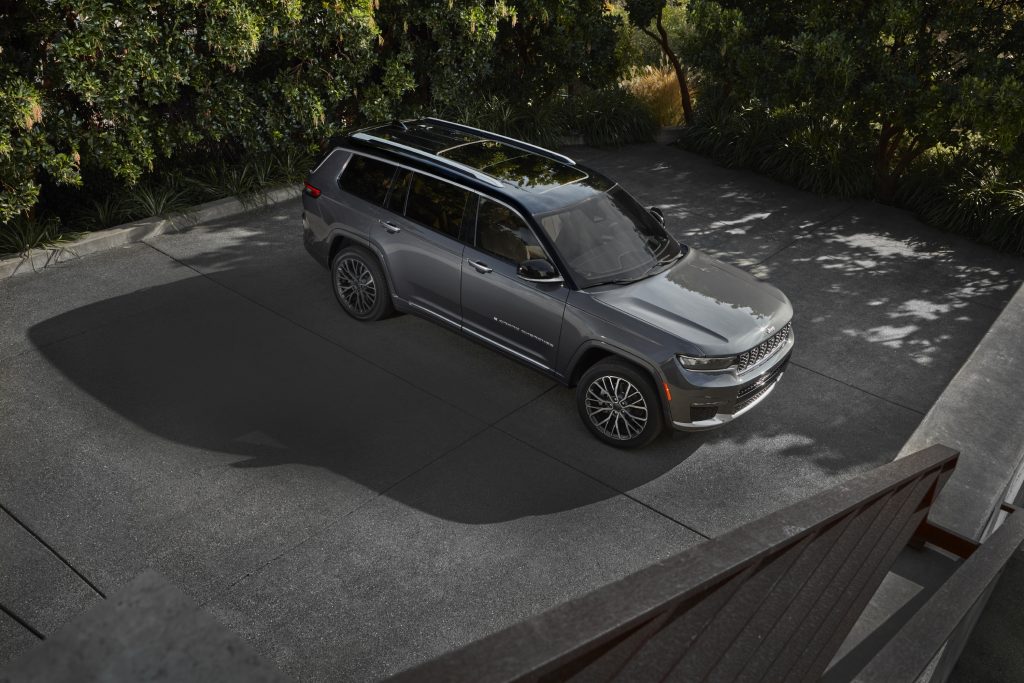
What’s it cost?
At 5204mm in length, with a wheelbase of 3091mm and tipping the scales at 2270kg, the Grand Cherokee L is a big sucker.
Nowhere is this size more apparent than in its long profile, but it’s a looker.
With more of an on-road focus, it comes in four flavours, starting with the Night Eagle priced from $82,750 plus on-road costs.
It’s followed by the Limited, from $88,750, Overland, from $103,250 and top of the line Summit Reserve, from $119,450.
Premium paint adds $1750, a sunroof $2450 (Night Eagle), dual-pane sunroof and head-up display $4250 (Limited), while head-up display, wireless phone charging, night vision and front passenger interactive display are bundled at a cost of $5500 for the Summit Reserve.
Our test vehicle, the Summit Reserve finished in standard bright white, came with all the options, pushing it to $130K plus by the time it hits the road.
Standard kit across the range includes climate air, leather-trimmed, heated and power-adjust front seats with electric lumbar adjustment, auto LED headlights and a height adjustable power operated tailgate.
By the time you reach the Summit it has 21-inch polished alloys, four-zone air, ventilated, 12-way adjustable front seats with memory and massage function that are hand-wrapped in quilted leather, open-pore waxed walnut wood finishes and power-folding second and third-row seats.
There’s also auto high beam, auto lights and wipers, power-adjust steering column, a digital rear view mirror, front and rear parking sensors, parallel and perpendicular parking, and adaptive cruise control with stop and go.
Infotainment includes a slick 10.1-inch touchscreen, Bluetooth, voice control, built-in navigation, AM/FM and DAB+ digital radio, plus wireless Apple CarPlay and Android Auto.
Summit also includes a bespoke 950 watt, 19-speaker McIntosh audio system specifically tuned to the vehicle’s layout.
Night vision projects a greyscale image of the darkened road ahead in the centre of the instrument cluster and might be helpful in avoiding kangaroos and the like.
And here’s a first – an interactive, front passenger touchscreen is integrated into the front of the glovebox.
It allows the passenger to stream music wirelessly to the audio system, view the GPS map and send destinations directly to the centre touchscreen.
The display features a special coating that allows only the front passenger to view it while the vehicle is in motion.
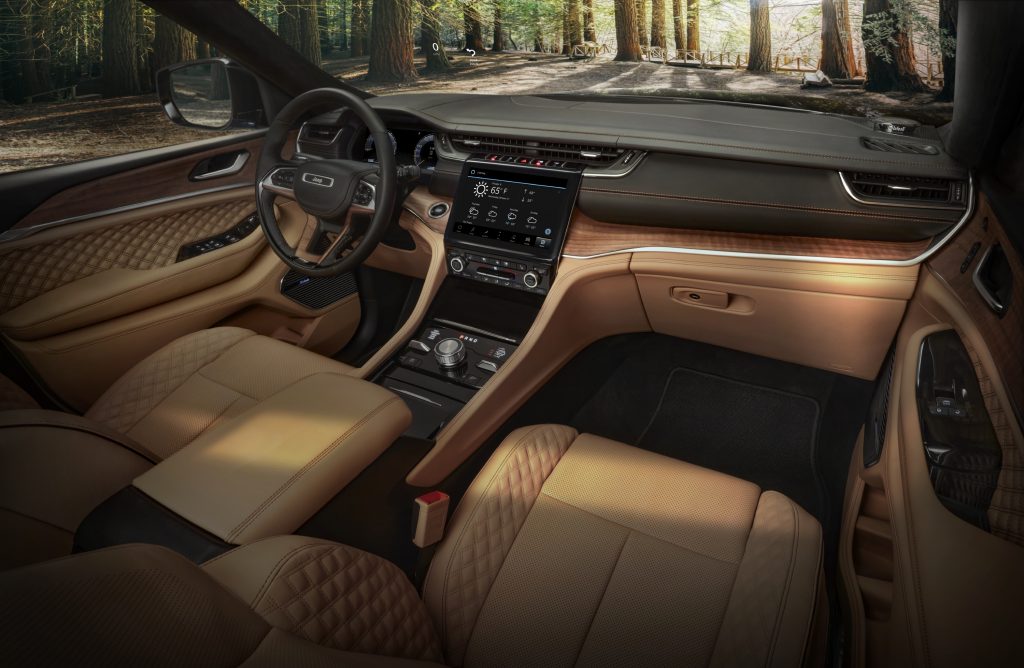
The centre console bristles with media options including wireless charging, 4 x USB (2x USB-A and 2 x USB-C), HDMI and Aux ports, together with a 12-volt outlet.
There are also four USB charge ports for second and third rows and another 12-volt outlet in the cargo area.
Grand Cherokee’s five-star safety rating expired in December.
Safety kit includes multiple airbags, a surround view camera and autonomous emergency braking (with cyclist and pedestrian detection).
There’s also blind spot monitoring with rear cross-path detection, active lane management, drowsy driver detection and traffic sign recognition.
Grand Cherokee L is covered by a five-year, 100,000-kilometre warranty, along with lifetime roadside assistance when serviced by Jeep.
Service is $399 a pop, with intervals spaced at 12,000km or 12 months.
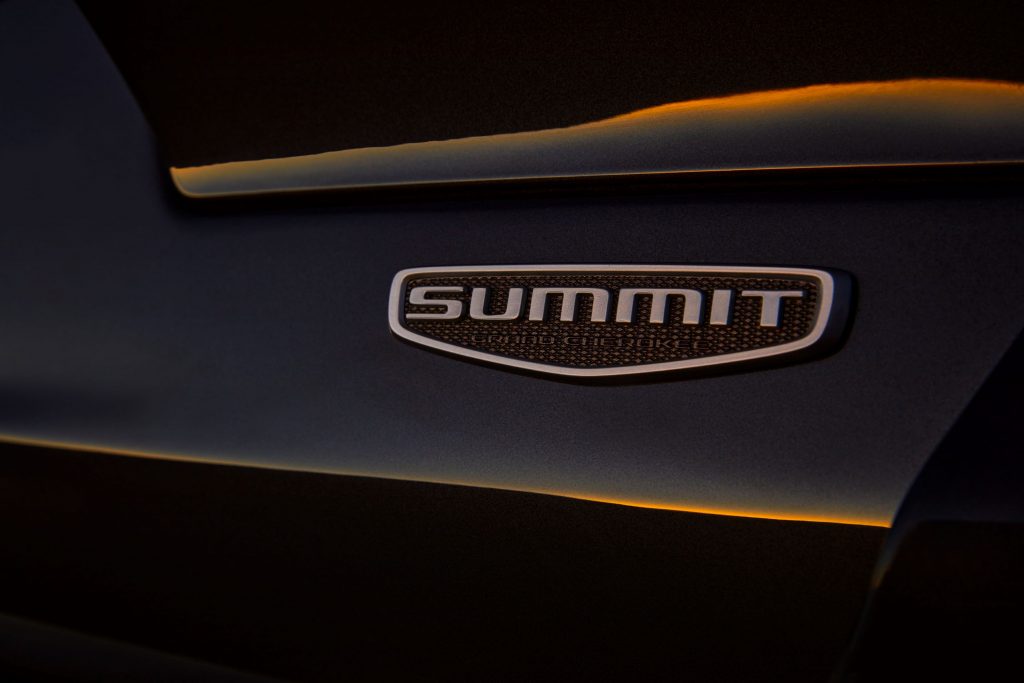
What’s it go like?
It doesn’t matter which grade you choose, they’re all powered by the same 3.6-litre Pentastar petrol V6, with 210kW of power at 6400 rpm and 344Nm of torque on tap from 4000 rpm.
The V6 is paired with an eight-speed conventional automatic, with drive to all four wheels, steering wheel-mounted gear change paddles and auto engine-stop-start to help save fuel.
The Australian SUV market is a diesel one and has been for a long time.
As diesel is being phased out, petrol-electric hybrids are becoming the default position for large SUVs like this one.
But for some brands, Jeep included, the transition is not happening quickly enough and it has been caught in the middle, forced to offer a big, thirsty petrol V6 rather than withdraw from the marketplace.
Fuel consumption from the 87-litre tank is rated at 10.6L/100km. That’s on a good day and therein lies the problem.
Ouch!
In the Summit, drive is to all four wheels, as required via a Quadra-Trac II Active 4×4 System with high and low range gearing, Selec-Terrain off-road modes and Quadra Lift Air Suspension with semi-active damping.
Didn’t notice a ‘Trail-rated’ badge however.
Cylinder deactivation would have been handy and the V6 has certainly been engineered to comply, but alas, it is not offered.
Further, this particular engine has been around for more than a decade and features sequential, multi-port fuel injection rather than more efficient direct injection.
Having said that, it goes okay, with plenty of punch, but it’s not what we’d describe as quick.
It’s more a case of having a look-see, then winding it up before deciding whether to overtake.
Maximum torque does not arrive until around the 4000rpm mark and it shows in its lack of response out of the gates.
Sport mode is offered and you can change gears manually using the paddle shifts, but the paddles are small and difficult to reach for those with short fingers.
The air suspension automatically adapts to different terrain, as well as dropping the car to allow easier entry and exit and sitting low on the freeway to optimise aerodynamics.
The converse applies off road where the system can raise the body to avoid obstacles.
At its highest setting it provides 276mm of ground clearance and a wading depth of 610mm.
But to be honest we never really contemplated taking this particular model bush bashing and frankly we’d be surprised if anyone does, not with easily damaged 21-inch wheels and pricey Continental rubber – despite its 4×4 credentials.
Air suspension may be useful in rough terrain, but on anything but well-formed bitumen we found the ride in the car harsh and unforgiving, transmitting the smallest imperfections through the wheels to the cabin.
Grand Cherokee L is 127mm longer than the five-seat version and 175mm longer than the model it replaces, with independent front and multi-link rear suspension.
Despite its size it has a rather low 2813kg tow rating (We think it’s actually 2280kg, an odd number that equates to 5000lbs – Ed.).
The cabin exudes class with quilted leather and real wood inlays.
But we’d be happier with the standard black interior rather than the very American tobacco-coloured wood and upholstery.
Both the second and third row of seats can be dropped at the push of a button and in the case of the third-row pack flat when not required.
But you need to clear the floor in front of the second row to access the rear seats and deploying the third row requires grappling with a rather cargo compartment cover before you can do so (and finding somewhere to stow it).
A fully digitised instrument cluster offers a bewildering array of options, but you shouldn’t have to go looking for distance to empty.
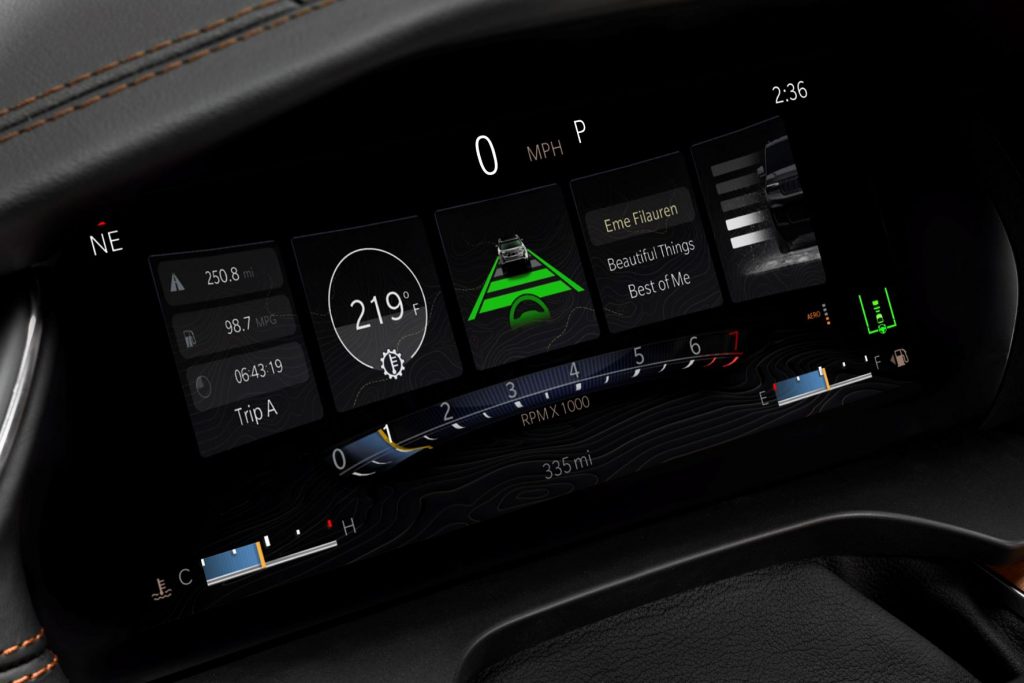
The McIntosh sound system is impressive, but the digital radio signal drops out a lot.
Other niggles include a jerky throttle, brakes that bite hard at the slightest provocation and a lane assist system that intervenes and often brakes at inappropriate moments.
After more than 800km of easy, mainly country kilometres, we were getting 10.9L/100km, which is not far off the manufacturer’s claim.
Around town however we’d expect the figure to be in the mid-13s, depending on how you drive.
Although it has a sizeable tank, it doesn’t take long before the fuel gauge is begging for more.
Thankfully, in one small concession, it accepts standard 91 RON unleaded.
What we like
- Big
- Classy
- Seats seven
- Lots of gadgets
- Impressive sound system
What we don’t like
- Thirsty
- No diesel or hybrid alternative
- Harsh ride off the freeway
- Over anxious brakes
- Change paddles too small
What over-50 drivers need to know
No thanks.
It’s big and classy, and has more toys than an amusement park.
But the Grand Cherokee L uses too much fuel and the ride quality leaves a lot to be desired once you leave the freeway.
Older drivers can find better value, more comfort and convenience in other brands, as well as seven seats if you need them.

seniordriver comments
The top-of-the-line Jeep Grand Cherokee offers a lot of car for the money. But it is a lot of money!
If past experience is anything to go by, that won’t dissuade a lot of buyers, especially those who have been waiting for a Grand Cherokee with three rows of seats.
What may deter some of them is the unavailability of diesel variants, and some may prefer to wait for the hybrid and electric powertrains that are on their way.
We’d also be concerned that the Grand Cherokee is now effectively not ANCAP-rated, since this expired in December. The two-row Grand Cherokee scores a five-star Global NCAP rating, but that’s a lot less stringent than our ANCAP requirements.
We’ve commented in the text that Chris has quoted a towing rating of 2813kg. However, our enquiries suggest it is more likely to be 2268kg (the odd number accounted for because it equates to 5000lbs). We’d be surprised if the Australian towing capacity is higher than that in the US for the same vehicle, but if you’re planning on using the big Jeep to tow, it’s worth enquiring before you purchase.
Like many new vehicles, much of the technology is far too challenging and fiddly to navigate. As Chris rightly points out, it shouldn’t be necessary to go searching for something as simple as Distance to Empty.
